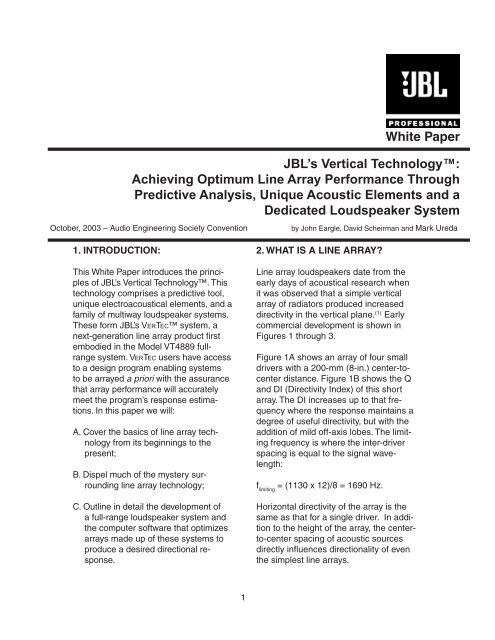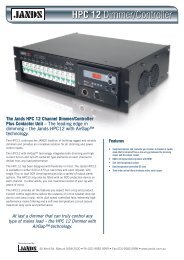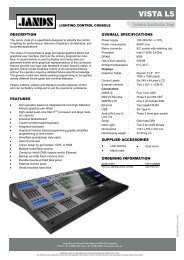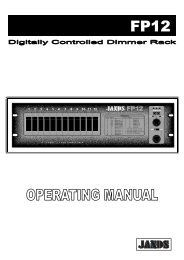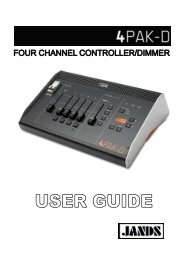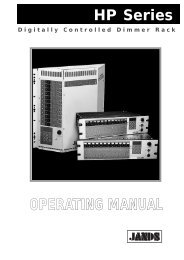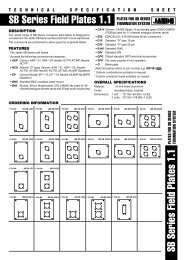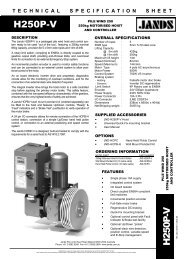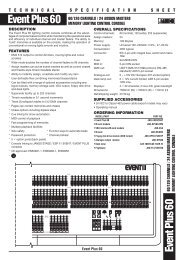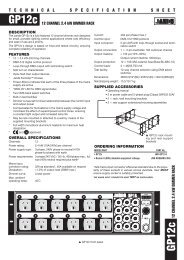VERTEC White Paper.indd - Jands
VERTEC White Paper.indd - Jands
VERTEC White Paper.indd - Jands
Create successful ePaper yourself
Turn your PDF publications into a flip-book with our unique Google optimized e-Paper software.
<strong>White</strong> <strong>Paper</strong>JBL’s Vertical Technology:Achieving Optimum Line Array Performance ThroughPredictive Analysis, Unique Acoustic Elements and aDedicated Loudspeaker SystemOctober, 2003 – Audio Engineering Society Conventionby John Eargle, David Scheirman and Mark Ureda1. INTRODUCTION:This <strong>White</strong> <strong>Paper</strong> introduces the principlesof JBL’s Vertical Technology. Thistechnology comprises a predictive tool,unique electroacoustical elements, and afamily of multiway loudspeaker systems.These form JBL’s <strong>VERTEC</strong> system, anext-generation line array product firstembodied in the Model VT4889 fullrangesystem. <strong>VERTEC</strong> users have accessto a design program enabling systemsto be arrayed a priori with the assurancethat array performance will accuratelymeet the program’s response estimations.In this paper we will:A. Cover the basics of line array technologyfrom its beginnings to thepresent;B. Dispel much of the mystery surroundingline array technology;C. Outline in detail the development ofa full-range loudspeaker system andthe computer software that optimizesarrays made up of these systems toproduce a desired directional response.2. WHAT IS A LINE ARRAY?Line array loudspeakers date from theearly days of acoustical research whenit was observed that a simple verticalarray of radiators produced increaseddirectivity in the vertical plane. (1) Earlycommercial development is shown inFigures 1 through 3.Figure 1A shows an array of four smalldrivers with a 200-mm (8-in.) center-tocenterdistance. Figure 1B shows the Qand DI (Directivity Index) of this shortarray. The DI increases up to that frequencywhere the response maintains adegree of useful directivity, but with theaddition of mild off-axis lobes. The limitingfrequency is where the inter-driverspacing is equal to the signal wavelength:f limiting= (1130 x 12)/8 = 1690 Hz.Horizontal directivity of the array is thesame as that for a single driver. In additionto the height of the array, the centerto-centerspacing of acoustic sourcesdirectly influences directionality of eventhe simplest line arrays.1
Figure 1. A 4-elementline array (A); directivityof 4-elementarray (B).array at higher frequencies enabled it tohold its consistent coverage pattern withincreasing frequency. Klepper & Steele(1963) devised a unique, low-cost way toaccomplish the progressive truncation ofthe array length with increasing frequencythrough a gradual high frequencyrolloff of the outer elements. (2) Theyemployed carefully tapered wedges offiberglass in front of the transducers toact as progressive acoustical low-passfilters.Meanwhile, Hilliard (1970) was addressingaspects of motion picturesound with vertical columns of LF drivers.As his analysis tool he constructedarrays of small drivers and then scaledthe results to give the response for 15-inch driver arrays. (3)If we want increasedvertical directivity wecan use more drivers.Figure 2A and Bshow the effect of an8-driver array with thesame 200-mm (8-in)spacing. The arrayachieves very highdirectivity in the rangeup to the limitingfrequency of 1690 Hz;however, above thatfrequency the off-axislobing becomes verysignificant, and anydirectivity advantagedrops off quickly.Overall, line arrays of the sort discussedhere were excellent for speech or solovocal purposes in moderate size rooms.Array theory was rarely if ever applied tohigh level music reinforcement, primarilybecause the available systems werephysically small. Most commercial arrays,or “sound columns,” made use of8-inch or smaller cone drivers and wereclearly limited in their output capability.It was soon discoveredthat reducingthe length of theFigure 2A. An 8-element line arrayFigure 2B. Directivity of 8-element array (B).2
2.1 JBL’S EARLY LINE ARRAYSYSTEMS:JBL developed a number of line arraysystems during the 1970s. The 4682,shown in Figure 3, is typical. Full powercapability of the four 10” drivers, arrangedin a vertical line format, wasmaintained at frequencies up to 2 kHz.At one-tenth its rated power, this systemwas capable of producing 96 dB SPL ata distance of 15.25 meters (50 ft).JBL’s early line array system productswere based on the foundations of acousticalknowledge gained from decadesof previous experimentation by soundreinforcement industry pioneers. Thisexperience was applied for the benefitof professional users, and it led to thecreation of new high-powered transducersable to take portable soundreinforcement systems to a new level ofperformance. Astute observers will beable to draw links betweenthe Model 4682system shown hereand innovative toursound products thatemerged in the sametime period.Figure 3. The JBL Model 4682line array from the 1970s.At the core of JBL’s VerticalTechnology programis the recognitionthat the same line arrayphysics established byindustry pioneers, andevidenced in productslike the Model 4682 linearray system nearly30 years ago, are applicableto modern,modular array elementsand are thus scalablefor use in larger-formatsystems.3. BASIC LINE ARRAY THEORY:3.1 THE SUMMATION MODEL:The arrays discussed so far can beeasily analyzed, and their directionalresponse can be determined using adiscrete, or summation, model.In this analytic approach, the array isbroken down into component elementswhose outputs are summed to producethe array’s net response. The summationis taken to arrive at the array’s responseas it would be observed in the far field— the region in which inverse squarelaw holds, with its characteristic falloff of6 dB per doubling of distance.The far field begins at a distance that isproportional to the product of frequencyand the square of the effective arraylength. At closer distances, we are in thenear field, where the falloff with distancefrom a simple array does not follow inversesquare law. Because it is an interferencefield, the changes in level withdistance and/or angular displacement canbe abrupt and unpredictable in the nearfield.If we use the summation model andwe assume that all elements are drivenby the same signal, that the outputamplitude and phase relationships areidentical for all elements, and that theelements are all omnidirectional, thenthe directional response can be given bythe following equation:(1)where n is the number of elements inthe array and d is the spacing betweenthem. (4,5) Let’s use this relationship todetermine the response of Hilliard’svertical array of 127 mm (5-in) drivers asshown in Figure 4A.3
Figure 4A. Hilliard’s 6-element line array of5-inch driversHere, the numberof elements is 6and the spacingbetween them is5 inches. Usingthe summationmodel equationwe arrive at thepolars shown at4B for 500 Hzand 1 kHz. The500 Hz polarshows a single,broad major lobe.This demonstratesgood directivity at this frequency.The 1 kHz polar shows the formationof a narrower primary lobe with smallersecondary (off-axis) lobes.Figure 5. Graphical representation of the producttheorem.Thus, if the individual driver beams athigh frequencies, the net array responsewill be impacted by this same beaming.This will be superimposed on the arrayresponse as determined by Equation 1.4. LINE ARRAY THEORY USINGTHE INTEGRATION MODEL:As long as we compose our line arrayof individual, discrete elements thenequation (1) will give us the answers weneed. However, it is important to note:Figure 4B. Hilliard’s polar response at 500 Hzand 1 kHz (B).3.2 THE PRODUCT THEOREM— PERFORMANCE AT HIGHERFREQUENCIES:The product theorem states that theresponse of an array can be obtainedby multiplying its directional responseby the response of a single elementin the array. (6) This definition is showngraphically in Figure 5. The first producttheorem allows us to make a betterapproximation of an array’s directivityby multiplying the known directionalcharacteristics of a non-simple sourceby the directional characteristics of anarray of simple sources.If we design new loudspeaker componentsthat can be combined to form acontinuous “ribbon” or line from top tobottom, we need a new mathematicalmodel to describe it.Without burdening the reader with therigors of the math involved, we’ll godirectly to the governing equation:(kl/2 = pl/l, where l is the array length) (2)This equation enables us to determinethe response of the continuous array inthe far field.4
Each frequency section should form acontinuous virtual ribbon relative to itsoperating frequency range for the arrayto function properly. Gaps between cabinetsshould be minimized and remainconstant for all splay angles betweencabinets to prevent destructive interferenceat high frequencies.Two MF sections flank the triple HF diffractionslot. Each of these contains two200 mm (8-in) neodymium drivers withdual voice coils, working into compressionslots located along the waveguideexpansion of the HF section. On the outsideare a pair of 380 mm (15-in) drivers.Crossover frequencies are roughly 200Hz and 1.1 kHz with specific overlappingcharacteristics, so both LF and MF systemsare effectively continuous radiatorsover their ranges of wavelength operation,resulting in a nested array of LF,MF and HF sections, as indicated at 8A.Precise control of HF radiation in theproprietary waveguide is enabled bygeometrical tapering of the path fromeach HF driver to the diffraction slot toensure that there is no vertical beamingover the HF passband of the system.Because of the close nesting of HF andMF elements, advanced acoustical andmechanical engineering was required.This included the waveguide boundariesthat load the HF drivers and the compressionloaded slots through which theMF drivers radiate.A new Radiation Boundary Integrator(RBI) was devised to allow the exit ofHF acoustical energy past a boundarysurface which is integral to MF radiation,making it virtually “invisible” to MF powerradiation. This results in a smoother coveragepattern while reducing intermodulationdistortion.Figure 9 shows the horizontal polars forthe VT4889 system. These indicate theeffective horizontal coverage of a typicalvertical array of the elements, and thatresponse is largely independent of thevertical articulation of elements.Figure 9. Horizontal polar response of a singleJBL VT4889 system.6.1 MECHANICAL DETAILS OFTHE VT4889 SYSTEM:We have seen in Section 4 that a continuousribbon of sound with no gaps inthe radiating surface is preferable, andin Section 5 we noted that arrays mayneed to be curved to adequately covertypical audience areas. The <strong>VERTEC</strong> systemenclosures have been designed totake maximum advantage of these twoacoustical requirements.Measuring only 1213 mm x 489 mm x546 mm (47.75” W x 19.25” H x 21.4”D), each enclosure includes all requiredhanging and rigging hardware fittings tocouple one box to another.To make field handling easier and to enablesystems users to create very largearrays, the individual box weight of thefull-size VT4889 is only 72 kg (159 lb.),7
despite a transducer complement thatincludes (2) 600-watt LF drivers, (4)400-watt MF drivers, and (3) 100-wattlarge format HF compression drivers.Due to the low individual weight of eacharray element, up to 18 VT4889 systemscan be suspended from a singleVT4889-AF hanging Array Frame, witha 7:1 design factor. The enclosure’scompact size allows it to be stacked onend,two-high in typical transport truckbodies with interior ceiling heights aslow as 2438 mm (96 in).7. CASE STUDIES:With JBL’s Vertical Technology, thehorizontal coverage of an array is fixed(nominally 90°) and thus becomes a“constant” baseline on which the <strong>VERTEC</strong>system engineer can build a wellplanned event or venue sound design.The primary tool is the software predictionprogram which enables the userto preview the expected results from thenumber of enclosures and their hingebar(vertical displacement) angles toachieve optimum coverage of the audienceseating areas.The <strong>VERTEC</strong> Line Array Calculator, asoftware tool based on Microsoft Excel,allows the design engineer to selectthe number of array elements andindividually adjust the splay anglesbetween adjacent elements. The designercan specify up to three seatingplanes and determine the front-to-backdistances as well as the slope of eachplane, all relative to the location of theline array. The program then asks theuser to select a frequency (one-third octavecenters from 100 Hz to 20 kHz).When a frequency is selected the programcalculates the vertical polar plot ofthe line array on 1-degree incrementsand indicates the front-to-back centerlinecoverage in dB on each of the threeseating planes.Through an intuitive process of entering,observing, and changing the angular relationshipsbetween adjacent elements,the designer can fairly rapidly arrive ata target directional function for any arrayof multiple enclosures. Additionally,useful mechanical information such asoverall array weight, sizing and such isavailable to the system engineer.Figures 10 through 12 show typical dataproduced by the design program, comparedto actual field measurements ofthe same array that is depicted in thesoftware.Note that all field measurements weretaken in a half-space groundplaneenvironment, with the measurementmicrophone positioned at a distance of20 meters.Figure 10A. Calculations vs. measurements.An 8-element array (A).8
It should be pointed out that the angular range of the computed polar plot consists onlyof the forward 120 degrees of the system’s response; this range is marked off in themeasured polar plots. It is clear that the program’s estimates of polar response veryclosely match the measured data, consistent with the 5-degree resolution of the measurements.An 8-element array is shown at A. The computed polar plot at 250 Hz is shown at B,along with the actual, measured 20-meter polar response at C.Figures 10B & C. Calculations vs. measurements. Computed polar response at 250 Hz (B);measured polar response at 250 Hz (at 20 meters) (C).9
Figure 11 shows corresponding computed and measured data at 1 kHz. The polar dataproduced by the design program are computed on one-degree increments, whereasthe measured polar data are taken every 5 degrees.Figure 11. Calculations vs. measurements.Computed polar response at 1 kHz (A); measured polar response at 1 kHz(at 20 meters) (B).10
Figures 12A and 12B show corresponding data at 4 kHz.Figure 12. Calculations vs. measurements.Computed polar response at 4 kHz (A); measured polar response at 4kHz (at 20 meters) (B).11
Figure 13. JBL VerTec line array calculator: Full computer display.12
In order to give the reader an idea of thefull scope of the <strong>VERTEC</strong> Line Array Calculatordesign program, Figure 13 illustratesa full-screen view of the program,showing mechanical details of the array,effective polar data, and uniformity ofcoverage on any selected seating plane.Note an array of eight (8) full-sizeVT4889 enclosures has been selected,with an array aiming angle (‘Box 1’) of2 degrees downtilt, with individual boxaiming angles set at 0, 0, 2, 4, 6, 8 and10. The graphic figure at the lower centerof the display shows the predictedsound pressure level of the array at 250Hz, from the first to last seating rows.Array design, splay angles and performanceresults will vary when the midsizeVT4888 or compact VT4887 multiwayline array element are used.CONCLUSIONSThe introduction of JBL’s Vertical Technologyhas taken the mystery andmythology out of line arrays. It has beenshown that classical array acousticswhich were used to create first-generationline array systems more than50 years ago still hold true today, andthat the same mathematical conceptsexplained by classical acoustical researcherslike Beranek, Olson and Hilliardcan be scaled up to create higherpoweredline array systems capable ofserving the sound reinforcement needsfor both voice and music in even thelargest of performance venues.JBL’s <strong>VERTEC</strong> line array systems, withtheir unique suspension hardware system,provide a continuous baffle surfaceand can be configured into straight-linearrays, uniformly and non-uniformlycurved arc arrays, progressive spiral,and J-form arrays. They are representativeof the dramatic evolution of the originalcompact ‘speaker column’ that wasfirst explored by such early practitioners.Such flexible, full-bandwidth arrays offera powerful new set of tools for the soundreinforcement industry. (7)One of the most significant things tocomprehend is that, regardless of originor manufacturer, when modular elementsare combined into a line array, theobserver should not, and indeed cannot,expect the axial directivity of the largerarray to behave as if it were simply acomposite stack of linear soundpaths,or ‘laser-like’ box angles. The observerwill come to understand that the array’sperformance should be evaluated holistically,rather than from the point of viewof discrete array elements.In effect, the performance of a modularline array, regardless of element sizeand the number included in the array,will be influenced by the acousticalcharacteristics and capabilities of eachindividual enclosure. Assuming a viabledesign for the individual enclosure, successfulfield deployments of line arraysystems can now be realized, rangingin size from small to large systems for avariety of venues and events. (8)The expectations of audiences andsound engineers alike have changedgreatly since the early days of acousticalresearch. New line array systemtools are now available to meet thoseexpectations of clear, articulate soundwith higher system output and greaterdynamic headroom potential. With theapplication of JBL’s Vertical Technology,the <strong>VERTEC</strong> system gives modern systemdesigners and operators that capability.13
BIBLIOGRAPHY:(1)Wolfe, I. & Malter, L. “DirectionalRadiation of Sound,” J. AcousticalSociety of America, volume 2, number2, p. 201 (1930).(2)Klepper, C & Steele, D., “ConstantDirectional Characteristics from aLine Source Array,” J. Audio EngineeringSociety, volume 11, number3 (July 1963).(3)Hilliard, J., “Unbaffled LoudspeakerColumn Arrays,” J. Audio EngineeringSociety, volume 18, number6 (1970).(4)Beranek, L., Acoustics, McGraw Hill,New York (1954).(5)Olson, H., Elements of AcousticalEngineering, p. 25. D. Van Nostrand,New York (1940).(6)Kinsler, L. & Frey, A., Fundamentalsof Acoustics, John Wiley & Sons,New York (1980).(7) Engebretson, M. “Directional RadiationCharacteristics of ArticulatingLine Array Loudspeaker Systems”,presented at the 111 th Convention ofthe Audio Engineering Society, NewYork, NY, December 2001.(8) Scheirman, D. “Practical Considerationsfor Field Deployment of ModularLine Array Systems”, presentedat the 21 st International Conferenceof the Audio Engineering Society, St.Petersburg, Russia, June 2002.14
JBL Professional8500 Balboa Blvd., P.O. Box 2200Northridge, CA 91329 U.S.A.Part # WP<strong>VERTEC</strong> 10/0316


